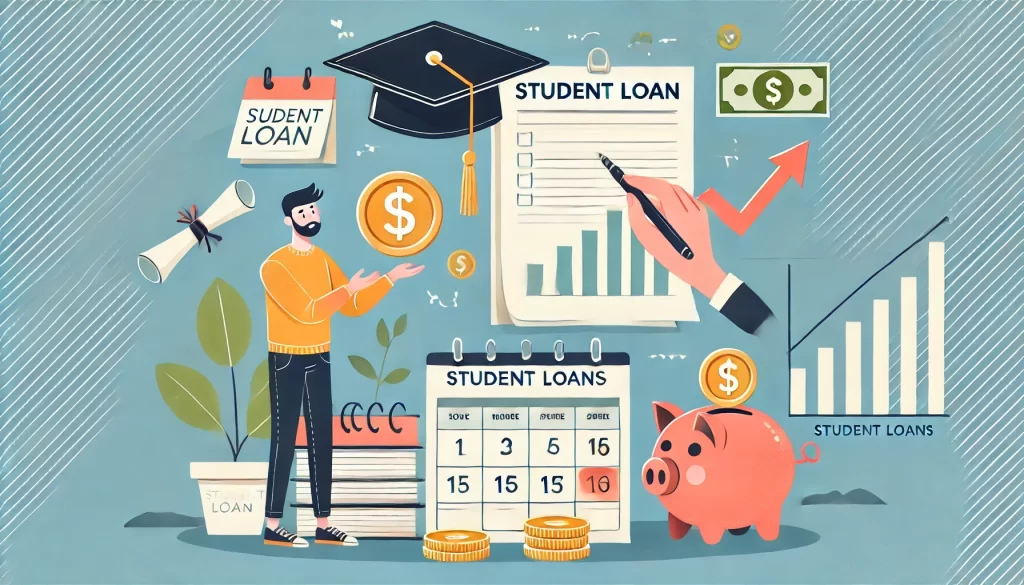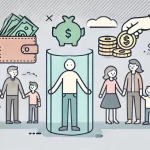I still remember the day I opened my first student loan statement. My heart sank as I stared at the six-figure sum. Like many millennials, I felt overwhelmed and unsure how I’d ever climb out of this financial hole. But then I stumbled upon Sofia Bastida’s story, and it changed everything.
Sofia, a 24-year-old first-generation Mexican American, paid off a staggering $120,000 in student loans in just 26 months. Her income? Below six figures. Her secret? Smart budgeting and unwavering determination. As I dug deeper into her journey, I realized that with the right strategies, financial literacy, and debt management skills, I too could conquer my student loan mountain.
Sofia’s story isn’t just inspiring; it’s a wake-up call for all of us struggling with student loan repayment. She faced a Parent PLUS loan that ballooned from $75,000 to $90,000 while she was still in school. But instead of letting the debt control her life, she took charge. She learned about refinancing, lowering her interest rate from 7.8% to 4.98%, and developed a system to pay off her loans quickly.
As I share these millennial budgeting tips for paying off student loans, I’m not just regurgitating financial advice. I’m sharing hard-earned wisdom from those who’ve walked this path before us. It’s time we tackle our debt head-on, boost our financial literacy, and create budgets that work for loan payments without sacrificing our dreams.
Key Takeaways
- Student loan repayment is possible with strategic budgeting
- Refinancing can significantly lower interest rates
- Developing financial literacy is crucial for debt management
- Creative income sources can accelerate loan repayment
- Lifestyle adjustments can free up money for debt payoff
- Persistence and determination are key to conquering student debt
Understanding Your Student Loan Burden
I’m exploring student loans to help you manage your debt. It’s important to understand your loans before you start paying them back. Let’s go through it step by step.
Analyzing Your Total Debt Amount
First, I need to find out how much I owe. The average federal student loan debt in the U.S. is $37,852.80. That’s a lot of money! I’ll collect all my loan documents and add up the total. Knowing this number is key to making a good repayment plan.
Interest Rates and Their Impact
Interest rates can greatly affect how much you pay back. I’ve learned that private student loan refinancing can lower interest rates. For example, some people have cut their rates from 7.8% to 4.98%, saving thousands. It’s definitely worth looking into!
Types of Student Loans You May Have
It’s important to know what kind of loans you have. Federal loans offer flexible repayment options, like income-driven plans that can lower payments to $0. Private loans might have stricter terms. Here’s a quick overview:
| Loan Type | Features | Repayment Options |
|---|---|---|
| Federal Direct Loans | Fixed interest rates, forgiveness options | Income-driven plans, federal loan consolidation |
| Private Loans | Variable or fixed rates, credit-based | Refinancing for interest rate reductions |
| Parent PLUS Loans | Federal loans for parents | Income-Contingent Repayment after consolidation |
Federal loans have perks like the SAVE plan, which can forgive accrued interest if payments don’t cover it. Plus, automatic payments often get a 0.25% interest rate discount. These small perks can save a lot of money over time!
By understanding your loan burden, you can pick the best repayment strategy. Whether it’s federal loan consolidation or private refinancing, knowing your loans is the first step to financial freedom.
Creating a Strategic Budget for Loan Repayment
Budgeting for loan payments is crucial for financial success. By tracking my spending and cutting non-essentials, I’ve saved hundreds annually. Let’s explore some effective budgeting strategies.
Tracking Essential vs Non-Essential Expenses
I list all my expenses for a month to start. This helps me see where my money goes and find areas to cut back. I focus on essentials like rent and groceries over non-essentials like entertainment.
Implementing the Zero-Based Budgeting Method
I use the zero-based budgeting method to allocate every dollar of my income. This approach has improved my financial literacy and helps me avoid overspending. Here’s how I break down my budget:
| Category | Percentage | Purpose |
|---|---|---|
| Essentials | 50% | Rent, utilities, groceries |
| Discretionary | 30% | Entertainment, dining out |
| Savings and Debt | 20% | Loan payments, emergency fund |
Building an Emergency Fund While Paying Debt
I aim to save three to six months of living expenses for emergencies. This fund protects me from unexpected costs without adding to my debt. By balancing saving with loan payments, I’m working towards long-term financial stability.
Understanding early payoff benefits motivates me to stick to my budget. By paying extra when possible, I reduce the total interest I’ll pay over time. This strategy, combined with smart budgeting, is my path to becoming debt-free.
Smart Strategies for Paying Off Student Loans
I’ve found some great ways to pay off student loans quickly. Let’s look at these smart strategies.
Automating savings is a big help. I make a part of my paycheck go straight to my loan payments. This way, I’m less likely to spend it on other things.
Income-driven repayment plans are also good. They make your payments fit your income. For example, a $25,000 loan at 6.8% interest over 10 years might cost $288 a month. But with these plans, it could be less.
Don’t forget about tax benefits for loan payments. The government lets you deduct up to $2,500 of interest paid on qualified loans. This can help at tax time.
| Lender | Fixed APR | Variable APR | Max Rate |
|---|---|---|---|
| Earnest | 4.24% – 9.99% | 5.99% – 9.99% | 11.95% |
| SoFi | 3.99% – 9.99% | 5.99% – 9.99% | 13.95% |
| LendKey | Varies | Varies | N/A |
Lastly, check out employer benefits. Some companies pay up to $5,250 a year towards your loans. It’s worth asking if your employer offers this.
Creative Income Sources for Faster Debt Repayment
Paying off student loans can feel like a long journey. It takes the average borrower 20 years to pay off their debt. It’s time to think outside the box.
Side Hustles That Actually Work
Forget about traditional part-time jobs. I’ve found that thinking outside the box can lead to serious cash. “Junk flipping” is a strategy that’s gaining traction. It involves buying unwanted items and reselling them for profit.
Maximizing Your Primary Income
Don’t overlook your day job as a source of extra funds. I’ve learned that taking on more responsibilities or negotiating a raise can help. Every extra dollar counts towards paying off your loans.
Turning Skills into Extra Payment Money
Your talents can help you pay off loans faster. I’ve seen people teach fitness classes at local gyms for extra cash. Others have found success in transcription work for medical, legal, and business recordings.
By using these strategies, you could save thousands on interest and pay off your loans sooner. For example, on a $30,000 loan over 10 years at 6% interest, paying an extra $50 monthly can save $1,804. It can also cut 20 months off your repayment period. Get creative, stay focused, and watch those student loans disappear!
Loan Refinancing and Consolidation Options
Dealing with student loans can be hard. But, refinancing and consolidation can help manage your debt better. I’ve looked into these options and found some useful info.
Benefits of Private Loan Refinancing
Refinancing with a private lender can save you a lot. You might get a lower interest rate by combining loans. This means smaller payments and thousands saved over time.
You also get the benefit of having only one loan to deal with. It’s easier than handling many loans at once.
Federal Loan Consolidation Opportunities
For federal loan holders, consolidation through the government is an option. It merges your loans into one, making payments simpler. It might not save you money right away.
But, it keeps federal benefits like income-driven plans and forgiveness. These are important for your financial future.
Choosing the Right Refinancing Lender
Finding the right lender for refinancing is key. Look at interest rates, repayment terms, and borrower protections. Your credit score affects the rates you can get.
Remember, refinancing federal loans with a private lender means losing federal benefits. So, think carefully about your options.
| Option | Best For | Key Benefit |
|---|---|---|
| Private Refinancing | Saving money | Lower interest rates |
| Federal Consolidation | Simplifying payments | Keeps federal benefits |
Choosing between consolidation or refinancing depends on your financial situation. Think about your loans, current rates, and goals before deciding.
Lifestyle Adjustments for Debt Management
Managing student loans is more than just knowing about money. It’s about making smart choices in your life. Jennifer Chan, for example, paid off $50,000 in loans in just two-and-a-half years. She kept her spending at 50-60% of her income.
Chan’s budgeting is a great example of financial literacy. She set aside $200 for groceries and $150 for dining out each month. This strict budget helped her avoid default and explore options like deferment when needed. She also saved and planned for retirement, balancing debt repayment with future goals.
I’ve started tracking my daily expenses, just like Chan. It only takes five minutes each night to check my bank and note my spending. This habit is key for preventing default and keeping my finances in check.
Monthly budget reviews are crucial. I now have “coffee dates” with myself to review my spending. This regular check-in helps me stay focused on my debt goals and make any needed changes.
- Cut unnecessary services
- Make coffee at home
- Use grocery store loyalty programs
- Continue saving, even small amounts
These small changes make a big difference, freeing up more money for loan payments. By making these lifestyle changes, I’m not just managing debt. I’m building a strong financial future.
Conclusion
Paying off student loans is tough, but it’s possible with the right plan. Making a solid budget helps a lot. It’s shocking to see how much college costs have risen.
There are ways to make it easier. For example, the SAVE plan can save borrowers $20,000. Loan forgiveness programs also help those in public service. Many people, like teachers and nurses, have already gotten debt relief.
Getting rid of student loans has many benefits. It can increase your earnings and improve your credit score. It might even make you healthier. I’m determined to become debt-free by trying different strategies. I’m sure I can do it and have a better financial future.






